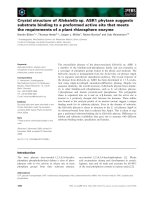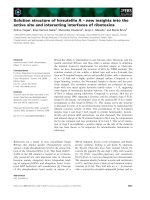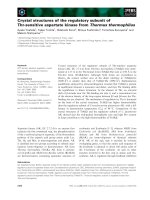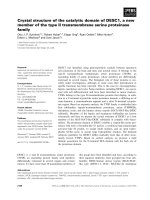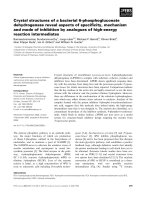Báo cáo khoa học: Crystal structure of Thermoanaerobacter tengcongensis hypoxanthine-guanine phosphoribosyl transferase L160I mutant ) insights into inhibitor design potx
Bạn đang xem bản rút gọn của tài liệu. Xem và tải ngay bản đầy đủ của tài liệu tại đây (978.68 KB, 8 trang )
Crystal structure of Thermoanaerobacter tengcongensis
hypoxanthine-guanine phosphoribosyl transferase L160I
mutant ) insights into inhibitor design
Qiang Chen
1,2
, Delin You
1
*, Yuhe Liang
1,2
, Xiaodong Su
1,2
, Xiaocheng Gu
1
, Ming Luo
1,3
and Xiaofeng Zheng
1,2
1 National Laboratory of Protein Engineering and Plant Genetic Engineering, Peking University, Beijing, China
2 Department of Biochemistry and Molecular Biology, College of Life Sciences, Peking University, Beijing, China
3 Department of Microbiology, University of Alabama at Birmingham, AL, USA
Parasites cause a wide variety of human and animal
diseases. These infections are routinely treated
using therapeutics such as chemotherapy. A common
approach for developing drug treatments against para-
sites is to target the biochemical and physiological
differences between a pathogen and host. In living sys-
tems, including humans, purine nucleotides are synthe-
sized using a de novo pathway and salvage pathway.
Most, if not all, protozoan parasites lack the de novo
pathway for synthesizing purine nucleotides. For this
reason, enzymes in the salvage pathway are potential
drug targets for the treatment of parasitic infections
[1,2]. Hypoxanthine-guanine phosphoribosyltransferase
(HGPRT; EC 2.4.2.8) is a key enzyme in the salvage
pathway for purine nucleotide synthesis, and converts
the nucleobases hypoxanthine and guanine to IMP
and GMP, respectively. The active site lies in a cleft
between the enzyme’s ‘core’ and ‘hood’ domains. Some
efforts have been made to identify inhibitors that tar-
get the active site of HGPRT [3–6].
The crystal structure of wild-type HGPRT from
Thermoanaerobacter tengcongensis was solved recently
[7]. In the present study, we sought to further our
understanding of HGPRT’s chemical mechanism and
to identify key residues that contribute to its activity
and regulation. We constructed a series of point
mutants, Leu160 and Lys133, and measured the
enzyme activity. These studies showed that mutating
Leu160 and Lys133 greatly reduced HGPRT activity,
which confirms that these residues play an important
Keywords
crystal structure; enzymatic activity; HGPRT;
mutant
Correspondence
X. Zheng, College of Life Sciences, Peking
University, Beijing 100871, China
Fax: +86 10 6276 5913
Tel: +86 10 6275 5712
E-mail:
*Present address
Shanghai Jiao Tong University, Shanghai,
China
(Received 23 April 2007, revised 17 June
2007, accepted 2 July 2007)
doi:10.1111/j.1742-4658.2007.05970.x
Hypoxanthine-guanine phosphoribosyltransferase (HGPRT) is a potential
target for structure-based inhibitor design for the treatment of parasitic dis-
eases. We created point mutants of Thermoanaerobacter tengcongensis
HGPRT and tested their activities to identify side chains that were impor-
tant for function. Mutating residues Leu160 and Lys133 substantially
diminished the activity of HGPRT, confirming their importance in cataly-
sis. All 11 HGPRT mutants were subject to crystallization screening. The
crystal structure of one mutant, L160I, was determined at 1.7 A
˚
resolution.
Surprisingly, the active site is occupied by a peptide from the N-terminus
of a neighboring tetramer. These crystal contacts suggest an alternate strat-
egy for structure-based inhibitor design.
Abbreviation
HGPRT, hypoxanthine-guanine phosphoribosyltransferase.
4408 FEBS Journal 274 (2007) 4408–4415 ª 2007 The Authors Journal compilation ª 2007 FEBS
role in catalysis. The crystal structure of the L160I
mutant of T. tengcongensis HGPRT was determined at
1.7 A
˚
resolution. Unexpectedly, the enzyme active site
was occupied by the N-terminus of a neighboring pep-
tide. This interaction suggests an alternative and
potentially useful strategy for designing inhibitors
against HGPRT.
Results
Design of HGPRT mutants
Based on the crystal structure of wild-type HGPRT
that our laboratory solved previously [7], Lys133 inter-
acts with the 6-oxo position on purines and is pro-
posed to be essential for substrate specificity. Leu160 is
below the purine that, together with Ile103, stabilizes
purine binding by van der Waals interactions. Both
Lys133 and Leu160 are relatively conserved among dif-
ferent HGPRTs from both eukaryotic and prokaryotic
organisms (Table 1), and the crystal structure confirms
that these residues are poised to function in catalysis.
Therefore, in the present study, we chose to modify
HGPRT at Leu160 and Lys133 to better understand
how this enzyme has developed its specificity for pur-
ine nucleosides.
Eleven mutants of HGPRT, L160I, L160V, L160T,
L160S, L160P, K133A, K133L, K133V, K133I, K133S
and K133T, were designed and crystallized and their
specific activities were compared (Table 2).
Protein purification and crystallization
All 11 HGPRT mutants were overexpressed and iso-
lated from the soluble fraction of Escherichia coli cells.
The overexpressed protein represented approximately
30% of the total protein and purified to near homoge-
neity (data not shown). We obtained crystals of
mutants L160I, L160T, L160S, L160V and K133I in
addition to a His-tagged wild-type HGPRT (Fig. 1).
Crystals of L160I diffracted to high resolution and
were subjected to structure determination. Crystalliza-
tion conditions of the other mutants are currently
being optimized to improve diffraction resolution and
quality.
Structure of the mutant L160I
The overall structure of the L160I mutant is in excel-
lent agreement with wild-type HGPRT (calculations
using the peptide backbone reveals an rmsd of 0.5 A
˚
between the two structures) [7]. The active site is in a
cleft between two domains: the core and hood. One of
the striking differences between the two structures is at
the N-terminus. Although the wild-type HGPRT has a
disordered N-terminus, the mutant L160I has an
extended loop (Fig. 2). The tetramer formation
observed for the L160I mutant is similar to that of the
wild-type HGPRT reported previously [7], although
the crystals belong to different space groups (wild-type:
C222
1
; L160I: I222). The four subunits of mutant
L160I tetramer are related by two orthorhombic two-
fold axes, whereas two subunits of wild-type HGPRT
in the asymmetric unit are related by a noncrystallo-
graphic two-fold axis and two asymmetric units
formed the tetramer through a crystallographic two-
fold axis.
We initially thought that the electron density in the
active site was GMP because the crystallization condi-
tions included four-fold excess GMP versus the pro-
tein [8]. However, after structure refinement, it was
clear that the electron density surrounding the
active site belonged to several N-terminal residues
(RGSHM) of the neighboring molecule (Fig. 3).
Among these resides, four were from the His-tag (the
full His-tag sequence is MGSSHHHHHHSSGLVPR-
GSH), and one was the first residue Met of the L160I
protein. The N-terminal arginine occupied the active
site whereas the upstream amino acids were exposed
to the solvent and could not be seen in the electron
density map because of their disordered conforma-
tions.
Table 1. Comparison of HGPRT active site residues that are involved in substrate recognition.
Species
Above
the
purine
Below the
purine
Interact
with purine
6-oxo group
Near
purine
C2 group Cis-peptide
Proposed
catalytic
base
Coordinates
with divalent
metal ion
Thermoanaerobacter tengcongensis F154 I103, L160 K133 V155, D161 L44, K45 D105 E101, D102
Homo sapiens F186 I135, L192 K165 V187, D193 L67, K68 D137 E133, D134
Toxoplasma gondii W199 I148, Y205 K178 I200, D206 L78, K79 D150 E146, D147
Tritrichomonas foetus Y156 I104, F162 K134 V157, D163 L46, T47 D106 E102, D103
Trypanosoma cruzi F164 I113, L170 K143 V165, D171 L51, K52 D115 E111, D112
Plasmodium falciparum F197 I146, L203 K176 V198, D204 L76, K77 D148 E144, D145
Q. Chen et al. Crystal structure of HGPRT L160I
FEBS Journal 274 (2007) 4408–4415 ª 2007 The Authors Journal compilation ª 2007 FEBS 4409
Crystal packing
L160I mutants exist as a tetramer in both solution and
crystals. The N-terminus of each subunit of the tetra-
mer forms crystal contacts with the active site of a
subunit of the neighboring tetramer. As a result, one
tetramer links to four other tetramers via the active
site and the recombinant N-terminal, which allows the
proteins to form an ordered network in the crystal lat-
tice (Fig. 4). This is likely the major reason why the
crystal could diffract to high resolution (> 1.7 A
˚
).
Several hydrogen bonds are present between the
N-terminus and active site. Ser-2 (residues in the recom-
binant His-tag are denoted with a minus sign to distin-
guish them from residues in the native protein) has a
backbone oxygen that hydrogen bonds with the side
chains of Lys133 and Arg136. Gly-3 backbone oxygen
interacts with Val155 backbone nitrogen and Lys153
backbone oxygen. Met1 backbone nitrogen interacts
with the Asp152 side chain. Several ordered water mole-
cules were present in the interaction between the
N-terminus and the active site. In addition, Arg-4 makes
van der Waals contacts with Phe154, Val155, Ile103 and
Ile160 to provide additional stabilization forces.
A calcium ion was identified near the N-terminus
connecting two tetramers. The calcium ion was coordi-
nated by the carboxyl side chains of Asp7 from one
tetramer, Asp135 from a neighboring tetramer, and
four water molecules, completing a perfect octahedral
coordination sphere. This interaction might promote
the formation of the protein network.
Enzyme activity
The specific activities of the wild-type and mutant
HGPRTs were measured and the results are summa-
rized in Table 2.
Leu160 and Lys133 mutants all showed decreased
rates of activity with respect to wide-type HGPRT.
Using hypoxanthine as the substrate, activity of
mutants L160S, K133V, K133I and L160I fell to 10%
to 19% compared to wild-type, whereas the activity of
mutants L160T, L160P, K133A, K133L, K133S and
K133T dropped to less than 5%. When guanine was
used as the substrate, the activity of L160T, K133A,
K133T, K133V fell to 18%, 14%, 13.8% and 23.6%,
respectively, compared to the wild-type, whereas the
activity for L160S, L160P, K133L, K133I and K133S
was less than 5%. Based on all mutants, L160V
showed the highest activity for both hypoxanthine and
guanine, yet it was still substantially less than the wild-
type HGPRT, especially when hypoxanthine was used
as substrate.
Table 2. The specific activity (lmolÆmin
)1
Æmg
)1
) of HGPRT wild-type and mutants. Reactions were carried out in 100 mM Tris ⁄ HCl buffer, pH 7.4, and 12 mM MgCl
2
at 37 °C. Data are
reported as the mean ± SD of triplicate measurements.
Substrate
Wild-type
(T7-tag)
Wild-type
(His-tag) L160I L160V L160T L160S L160P K133A K133L K133V K133I K133S K133T
Hypoxanthine 21.0 ± 0.66 18.4 ± 0.82 3.5 ± 0.14 8.5 ± 0.35 0.7 ± 0.03 1.8 ± 0.08 0.03 ± 0.01 0.7 ± 0.03 1.2 ± 0.05 3.3 ± 0.14 2.2 ± 0.09 0.2 ± 0.09 0.5 ± 0.03
Guanine 10.5 ± 0.45 14.4 ± 0.70 2.6 ± 0.13 10.3 ± 0.52 4.3 ± 0.22 0.9 ± 0.04 0.07 ± 0.02 0.2 ± 0.01 0.5 ± 0.03 3.4 ± 0.16 0.01 ± 0.01 0.09 ± 0.02 0.2 ± 0.02
Crystal structure of HGPRT L160I Q. Chen et al.
4410 FEBS Journal 274 (2007) 4408–4415 ª 2007 The Authors Journal compilation ª 2007 FEBS
Discussion
In the wild-type T. tengcongensis HGPRT structure,
Leu160, together with Ile103, stabilizes purine binding
by van der Waals interactions, and Lys133 is proposed
to be essential for substrate specificity [7]. Point
mutants of Leu160 and Lys133 had much weaker
activity compared to the wild-type, which confirms that
Leu160 and Lys133 are two key residues in catalysis.
Based on the crystal packing, the interaction
between the N-terminus and active site is essential for
the formation of well-ordered crystals. Qualitatively,
crystals of His-tagged wild-type HGPRT, mutant
L160V, L160T and L160S appear to be in good shape;
however, they diffracted weakly implying that the
L160I mutation is important in forming good crystal
contacts. The isoleucine probably provides an optimal
environment for Arg-4, which only makes van der
Waals interactions with the active site. The cyclic pro-
line may destroy the N-terminal peptide binding
because no crystals were observed for L160P. Among
the six mutants at Lys133, only one, K133I, formed
crystals which were very small (Fig. 1), and this sug-
gests that the hydrogen bond between Ser-2 and
Lys133 is essential for the binding of the N-terminal
peptide. If the N-terminal peptide could not bind the
active site properly, this peptide would become a dis-
turbance to the ordered arrangement of protein mole-
cules, thereby prohibiting crystallization.
Although there was a four-fold excess of the product
GMP to enzyme in the crystallization conditions, we
could not detect any electron density that accounted
for GMP in the L160I structure. Instead, the N-termi-
nal residues from a neighbor tetramer were found
occupying the active site. This observation suggests
that, compared to the natural product GMP, the
N-terminal peptide has stronger affinity for the active
site of mutant L160I.
The main goal of studying HGPRT function and
structure is to design compounds that would be effec-
tive inhibitors. Almost all of the inhibitors available
are analogues of the substrate or transition-state. The
main drawback of these compounds is that there is
poor differential inhibition among various HGPRTs.
The reason maybe due to high structure similarity of
His-tag WT L160I L160T
L160S L160V K133I
Fig. 1. Photographs of wild-type and mutant
HGPRT crystals.
N-terminal loop
II
III
I
IV
Fig. 2. Ribbon representation of T. tengcongensis HGPRT L160I
mutant subunit. The core domain contains a central five-stranded
parallel b-sheet flanked by three a-helices. The hood domain con-
sists of a small antiparallel b-sheet and two small 3–10 helices. The
four loops that make up the active site are labeled (I–IV).
Q. Chen et al. Crystal structure of HGPRT L160I
FEBS Journal 274 (2007) 4408–4415 ª 2007 The Authors Journal compilation ª 2007 FEBS 4411
HGPRTs from different species (especially the active
site) even though there is only moderate sequence
homology. The key residues in the active site are
highly similar among HGPRTs (Table 1). Thus, in
addition to targeting the substrate and cofactor bind-
ing sites, we propose another strategy to design inhibi-
tors that target unique regions surrounding the active
site. A compound that specifically binds such regions
in parasitic HGPRTs and that can also block the
active site may be a good approach for tackling
the differential inhibition problem. A similar strategy
was suggested previously [9,10], and the interaction
between the N-terminal residues and the active site in
the mutant L160I structure supports the feasibility of
this strategy. In the present case, we propose that a
peptide that can bind to the groove between the core
domain and hood domain, and also block the active
site, could be an effective inhibitor. One potential area
that may be exploited lies at Arg136 in T. tengcongen-
sis HGPRT, which forms hydrogen bonds with the
N-terminal peptide. After structural comparisons of
human HGPRT and all available parasitic HGPRTs
[11–15], we found that Tritrichomonas foetus, Trypano-
soma cruzi and Plasmodium falciparum HGPRTs
lacked a basic counterpart to Arg169 in human
HGPRT. Human HGPRT Arg169 corresponds to
Arg136 in the L160I HGPRT variant from T. tengcon-
geensis. Based on the crystal structure of mutant
L160I, Arg136 forms hydrogen bonds with the N-ter-
minal peptide using its side chain. Such differences
may provide the basis for designing inhibitors with
preferential selectivity towards parasitic HGPRTs.
Experimental procedures
Protein preparation, crystallization and data
collection
Wild-type HGPRT was cloned into a pET-15b vector (an
N-terminal His-tag was used instead of a T7-tag reported in
previous studies [7]) to facilitate protein purification and
comparisons with mutants. All mutants of T. tengcongensis
HGPRT, L160I (V, T, S and P) and K133A (L, V, I, S and
T), were cloned into a pET-15b vector using the GeneEditor
in vitro site-directed mutagenesis system along with the
wild-type vector as the template (Promega, Madison, WI,
USA). All mutations were confirmed by plasmid DNA
sequencing. Detailed protein overexpression and purification
A
B
Fig. 3. Close-up view showing the interac-
tions between the active site of T. teng-
congensis HGPRT L160I mutant with the
N-terminus of a neighboring molecule. (A)
Stereoview of an Fo–Fc omit electron den-
sity map for the N-terminal loop. The elec-
tron density map was contoured at 3r.
(B) Overview depicting two subunits
involved in protein–protein interactions
across subunits. One subunit is shown in
ribbons whereas its neighboring subunit is
rendered in Van der Waals surface. The
N-terminal loop is shown in CPK representa-
tion and C atoms are colored cyan to distin-
guish them from the other subunit.
Crystal structure of HGPRT L160I Q. Chen et al.
4412 FEBS Journal 274 (2007) 4408–4415 ª 2007 The Authors Journal compilation ª 2007 FEBS
protocols are reported elsewhere [8,16]. Briefly, overexpres-
sion of the protein was carried out in E. coli BL21(DE3) ⁄
pLysS cells. A two-step purification procedure involving a
nickel chelating column followed by a Superdex-75 size
exclusion gel-filtration was used to obtain near homogenous
protein. For crystallization trials, the purified protein was
concentrated to approximately 10 mgÆmL
)1
using Centricon
filter devices (Millipore, Billerica, MA, USA), set up in
16-well tissue-culture plates using the hanging-drop vapor-
diffusion method, and stored at 20 °C. For initial screening,
the protein was equilibrated against Hampton’s Crystal
Screen and Crystal Screen 2 kits (Hampton Research, River-
side, CA, USA). Protein solution (1 lL) was mixed with
1 lL of well solution on a siliconized glass cover slip, which
was then sealed with high vacuum grease over a well con-
taining 0.4 mL of the respective crystallization solution. To
fully saturate the enzyme binding site, GMP was added in a
4 : 1 molar ratio with respect to wild-type and mutant
HGPRTs. Single crystals of the L160I mutant grew in 0.2 m
calcium chloride, 0.1 m Hepes (pH 7.5), 28% polyethylene
glycol 400 (Hampton Crystal Solution #14) within 2 weeks.
X-ray diffraction data were collected by rotating the crystal
in 0.2° oscillations over a 180° wedge at k ¼ 1.5418 A
˚
, using
a Bruker SMART-6000 CCD detector (Bruker AXS GmbH,
Karlsruhe, Germany). Nitrogen gas was used to maintain
the crystal at 100 K and no cryoprotection was used. Data
processing was performed with Bruker Proteum, as reported
previously [8].
Structure determination and refinement
The structure of the T. tengcongensis HGPRT L160I mutant
was determined by molecular replacement using the wild
type HGPRT monomer (Protein Data Bank accession
no. 1R3U) as the search model. Rotation and translation
searches were carried out using the software cns [17] to
determine the position of one molecule in the asymmetric
unit. Initial rigid-body refinement was performed using data
between 20.0 and 2.5 A
˚
resolution resulting in a crystallo-
graphic R-factor (R
cryst
) of 36.7%. Manual substitution for
the L160I modification and model fitting were performed
using the software o [18]. Multiple rounds of conjugate gra-
dient minimization, simulated annealing and individual
B-factor refinement were performed. R
cryst
and R
free
dropped
to 28.4% and 34.2%, respectively. 3Fo)2Fc and Fo–Fc elec-
tron density maps were calculated using the refined model
phases. Data were collected to 1.70 A
˚
resolution, which
allowed for calcium ions and water molecules to be incorpo-
rated into the model during the latter stages of refinement.
Electron density maps showed one Ca
2+
in the active site.
Final R
cryst
and R
free
values were 20.3% and 22.4%, respec-
tively. Data refinement statistics are summarized in Table 3.
A
B
Fig. 4. Crystal packing of HGPRT L160I
mutant. (A) Each subunit of a tetramer (red)
links its N-terminus to the active site of a
neighboring tetramer subunit (green).
(B) Stereo diagram of the crystal packing
arrangement of the tetramers. The unit cell
is outlined by a green box.
Q. Chen et al. Crystal structure of HGPRT L160I
FEBS Journal 274 (2007) 4408–4415 ª 2007 The Authors Journal compilation ª 2007 FEBS 4413
Enzyme activity assay
To avoid complications due to the reverse reaction at longer
time points, all kinetic measurements were recorded using ini-
tial velocities of the forward reaction. Data were collected
with an Ultrospec 2000 UV ⁄ Visible Spectrophotometer
equipped with the kinetics program swift II (GE Healthcare,
Uppsala, Sweden). The formation of HGPRT-catalyzed IMP
or GMP was followed spectrophotometrically at 245 and
257 nm, respectively. All kinetic measurements were carried
out in 100 mm Tris ⁄ HCl buffer, pH 7.4, and 12 mm MgCl
2
.
Given the temperature-dependent pH shift of Tris ⁄ HCl
buffer (DpH ¼ )0.31 ⁄ 10 ° C), the buffer was readjusted to
pH 7.4 at the incubated temperatures. Under these
conditions, the extinction coefficients between IMP and
hypoxanthine, GMP and guanine were 1900 and
5900 m
)1
Æcm
)1
, respectively [18]. The assay was carried out
at 37 °C.
Acknowledgements
We would like to thank Dr Rieko Yajima for critical
reading of the manuscript and Professor Yicheng
Dong for helpful discussions. We thank Quan Yu for
help with protein gel-filtration analysis. This work was
supported by the National Science Foundation of
China (No. 30328006).
References
1 Wang CC (1984) Parasite enzymes as potential targets
for antiparasitic chemotherapy. J Med Chem 27, 1–9.
2 Ullman B & Carter D (1995) Hypoxanthine-guanine
phosphoribosyltransferase as a therapeutic target in pro-
tozoal infections. Infect Agents Dis 4, 29–40.
3 Bennett LL Jr, Brockman RW, Rose LM, Allan PW,
Shaddix SC, Shealy YF & Clayton JD (1985) Inhibition
of utilization of hypoxanthine and guanine in cells trea-
ted with the carbocyclic analog of adenosine. Phos-
phates of carbocyclic nucleoside analogs as inhibitors of
hypoxanthine (guanine) phosphoribosyltransferase. Mol
Pharmacol 27, 666–675.
4 Craig SP III & Eakin AE (1997) Purine salvage enzymes
of parasites as targets for structure-based inhibitor
design. Parasitol Today 13, 238–241.
5 Somoza JR, Skillman AG Jr, Munagala NR, Oshiro
CM, Knegtel RM, Mpoke S, Fletterick RJ, Kuntz ID &
Wang CC (1998) Rational design of novel antimicrobi-
als: blocking purine salvage in a parasitic protozoan.
Biochemistry 37, 5344–5348.
6 Aronov AM, Munagala NR, Ortiz De Montellano PR,
Kuntz ID & Wang CC (2000) Rational design of selec-
tive submicromolar inhibitors of Tritrichomonas foetus
hypoxanthine-guanine-xanthine phosphoribosyltransfer-
ase. Biochemistry 39, 4684–4691.
7 Chen Q, Liang Y, Su X, Gu X, Zheng X & Luo M
(2005) Alternative IMP binding in feedback inhibition
of hypoxanthine-guanine phosphoribosyltransferase
from Thermoanaerobacter tengcongensis. J Mol Biol 348,
1199–1210.
8 You D, Chen Q, Liang Y, An J, Li R, Gu X, Luo M &
Su XD (2003) Protein preparation, crystallization and
preliminary X-ray crystallographic studies of a thermo-
stable hypoxanthine-guanine phosphoribosyltransferase
from Thermoanaerobacter tengcongensis. Acta Crystal-
logr D Biol Crystallogr 59, 1863–1865.
9 Luecke H, Prosise GL & Whitby FG (1997) Tritricho-
monas foetus: a strategy for structure-based inhibitor
design of a protozoan inosine-5¢-monophosphate dehy-
drogenase. Exp Parasitol 87, 203–211.
10 Shen K, Keng YF, Wu L, Guo XL, Lawrence DS &
Zhang ZY (2001) Acquisition of a specific and potent
PTP1B inhibitor from a novel combinatorial library and
screening procedure. J Biol Chem 276, 47311–47319.
11 Shi W, Li CM, Tyler PC, Furneaux RH, Cahill SM,
Girvin ME, Grubmeyer C, Schramm VL & Almo SC
(1999) The 2.0 A structure of malarial purine phospho-
ribosyltransferase in complex with a transition-state
analogue inhibitor. Biochemistry 38, 9872–9880.
Table 3. Data collection and refinement statistics. Values in paren-
theses refer to the highest resolution shell.
Characteristic HGPRT mutant L160I
Data collection
Temperature (°K) 100
Space group I222
Unit cell length (A
˚
)a¼ 52.21, b ¼ 88.36, c ¼ 93.03
Unit cell angle (°) a ¼ b ¼ c ¼ 90
Resolution range (A
˚
) 20.0–1.70 (1.79–1.70)
Completeness (%) 97.4 (87.3)
R
sym
(%)
a
3.79 (10.76)
I ⁄ r (I) 14.4 (3.9)
Redundancy 3.53 (1.72)
Unique reflections 23 486
Subunits per asymmetric unit 1
Solvent content (%) 45.2
Refinement
Number of protein atoms in
an asymmetric unit
1446
Number of water molecules
in an asymmetric unit
186
R
cryst
(%)
b
20.4
R
free
(%)
c
22.6
B-factor
Average 18.0
Protein 16.4
Water 23.0
a
R
sym
¼ S|I – <I>| ⁄SI.
b
R
cryst
¼ S(||F
o
| ) |F
c
||) ⁄S|F
o
|.
c
R
free
is the
R-factor for a selected subset (approximately 10%) of the reflec-
tions that are not included in prior refinement calculations.
Crystal structure of HGPRT L160I Q. Chen et al.
4414 FEBS Journal 274 (2007) 4408–4415 ª 2007 The Authors Journal compilation ª 2007 FEBS
12 Shi W, Li CM, Tyler PC, Furneaux RH, Grubmeyer C,
Schramm VL & Almo SC (1999) The 2.0 A structure of
human hypoxanthine-guanine phosphoribosyltransferase
in complex with a transition-state analog inhibitor. Nat
Struct Biol 6, 588–593.
13 Somoza JR, Chin MS, Focia PJ, Wang CC & Fletterick
RJ (1996) Crystal structure of the hypoxanthine-guan-
ine-xanthine phosphoribosyltransferase from the proto-
zoan parasite Tritrichomonas foetus. Biochemistry 35,
7032–7040.
14 Focia PJ, Craig SP III, Nieves-Alicea R, Fletterick RJ
& Eakin AE (1998) A 1.4 A crystal structure for the
hypoxanthine phosphoribosyltransferase of Trypanoso-
ma cruzi. Biochemistry 37, 15066–15075.
15 Heroux A, White EL, Ross LJ, Davis RL & Borhani
DW (1999) Crystal structure of Toxoplasma gondii
hypoxanthine-guanine phosphoribosyltransferase with
XMP, pyrophosphate, and two Mg(2+) ions bound:
insights into the catalytic mechanism. Biochemistry 38,
14495–14506.
16 You DL, Qu H, Chen Q, Xing Y, Gu XC & Luo M
(2003) [Cloning, expression and characterization of the
hypoxanthine-guanine phosphoribosyltransferase
mutants from T. tengcongensis]. Sheng Wu Hua
Xue Yu Sheng Wu Wu Li Xue Bao (Shanghai) 35,
853–858.
17 Brunger AT, Adams PD, Clore GM, DeLano WL,
Gros P, Grosse-Kunstleve RW, Jiang JS, Kuszewski J,
Nilges M, Pannu NS et al. (1998) Crystallography &
NMR system: a new software suite for macromolecular
structure determination. Acta Crystallogr D Biol
Crystallogr 54, 905–921.
18 Jones TA, Zou JY, Cowan SW & Kjeldgaard M (1991)
Improved methods for building protein models in elec-
tron density maps and the location of errors in these
models. Acta Crystallogr A 47, 110–119.
Q. Chen et al. Crystal structure of HGPRT L160I
FEBS Journal 274 (2007) 4408–4415 ª 2007 The Authors Journal compilation ª 2007 FEBS 4415



